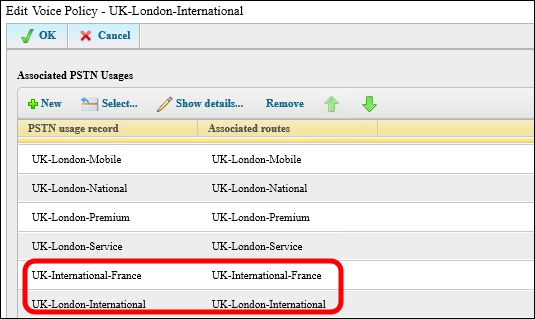In a previous recipe, we discussed M:N trunk routing, and we said that associating multiple gateways with a single Mediation Server adds resiliency and flexibility. In this recipe, we will see how to obtain three different results: load balancing, failover, and least cost routing.
Note
There are some limitations and compatibility requirements while implementing the solutions explained in this recipe. We can find a short explanation about them in the TechNet post M:N trunk in Lync Server 2013 at http://technet.microsoft.com/en-us/library/gg398971.aspx.
In the following recipe, we will add some gateways to our scenario and we will assume that they are already configured. The international.wonderland.lab gateway is the least costly gateway for international calls from UK to France. To enable failover routing, we will add another gateway failover.wonderland.lab.
- To configure load balancing, the first step is to take a list of the routes associated with a specific voice policy. For example, UK-London-National, which we created in a previous recipe, is associated with the following PSTN usage records: UK-London-Local, UK-London-Mobile, UK-London-National, and UK-London-Service. They have associated routes with the same name.
- We are required to define the PSTN gateways that we want to use to balance in each voice route. In the following screenshot, we are load balancing the UK-London-Mobile voice route:

Lync will load balance voice traffic using a round robin between the PSTN gateways defined in the various voice routes.
- As we mentioned in the Getting ready section of this recipe, we will add a PSTN gateway to our scenario, international.wonderland.lab, which is the least costly gateway for international calls from UK to France (the country code is +33).
- To enable least cost routing, we have to define a PSTN usage rule and associate it with a voice route that has to match calls to the CC +33. The route must be connected to the international.wonderland.lab gateway.
- With a cmdlet that we already used in the Configuring PSTN usage – voice policy recipe, we can define a PSTN usage record called
UK-International-France:Set-CsPstnUsage -Identity global -Usage @{add="UK-International-France"} - Using the Control Panel (as an alternative to the commands that we used previously in the chapter), we have to define a new voice route with the following parameters:
- Matching with the
^(?:00)(33d{9-10})normalization rule - Associated with the trunk that connects to the
international.wonderland.labgateway - Associated with the UK-International-France PSTN usage rule
The previously mentioned parameters are shown in the following screenshot:

- Matching with the
- After editing the UK-London-International voice policy so that the UK-International-France PSTN usage record is located above UK-London-International, we are sure that all the calls to a +33 phone number will use the least costly route. The configuration is the one shown in the following screenshot:

- To enable a failover route, we are required to edit voice policies so that we have more than one PSTN usage rule inside the single policy, and associated with different voice routes. If we have two voice routes available, the second one will be used as a failover. We will proceed to define a failover for the UK-London-National voice policy.
- We will define a new PSTN usage record UK-Failover:
Set-CsPstnUsage -Identity global -Usage @{add="UK-Failover"}Now, we will perform the following steps:
- A new voice route is required. We will call it
UK-National-Failover. It will be associated with the same normalization rules of the UK-London-National route. - Use the trunk to the failover.wonderland.lab gateway.
- Be associated with the UK-Failover PSTN usage rule.
The following image highlights the two voice routes:

- A new voice route is required. We will call it
- After editing the UK-London-National voice policy (for example) and applying the PSTN usage rules in the correct order, we defined a failover for the preferred voice route, as shown in the following screenshot:

Ken Lasko has dedicated a series of posts to Lync Enterprise Voice Misconceptions that also include important information about failover routing at http://ucken.blogspot.ch/2014/09/EVMisconceptionsRouting.html.
Keenan Crockett, in a blog post dedicated to Lync Server 2010, Distinguishing Between Voice Routes Configured for Load Balancing vs. Voice Policies Configured for Failover and Least Cost Routing in Lync Server 2010 (http://blogs.perficient.com/microsoft/2011/08/distinguishing-between-voice-routes-configured-for-load-balancing-vs-voice-policies-configured-for-failover-and-least-cost-routing-in-lync-server-2010/) outlined some scenarios for the different configurations, also pointing out some wrong ways to realize them.
